The Microsoft Surface Laptop 3 (15-Inch) Review: AMD Ryzen Surface Edition
by Brett Howse on October 21, 2019 9:00 AM EST- Posted in
- Laptops
- AMD
- Microsoft
- Surface
- Ryzen
- Surface Laptop
- Surface Laptop 3
AMD Ryzen Microsoft Surface Edition
Microsoft's decision to use an AMD processor was a bit of a surprise, since despite AMD’s resurgence in the desktop space, the company hasn’t spent as much of its focus on the laptop market. There are a multitude of reasons for this, but the end result has been that we haven't seen too many Ryzen Mobile laptops. AMD's biggest win to date has arguably been Lenovo's ThinkPad lineup, but getting into a Microsoft Surface machine is a greater achievement still.
The 15-inch Surface Laptop 3 incorporates what AMD and Microsoft are calling their "AMD Ryzen Microsoft Surface Edition" processor. Officially, they're classifying this as a semi-custom chip, though to quote our own Dr. Ian Cutress "the silicon inside the Surface Laptop 3 isn’t new: it is still the same Zen+ 12nm Ryzen silicon we see in other Ryzen notebooks today, however it has been binned specifically with 11 compute units at 15W, rather than what we see in the market today"
Still, what Microsoft is getting for their Surface Laptop 3 is not an off-the-shelf design. For their co-designed platform, there are two important aspects that give them a semi-custom spin on things. First off, Microsoft is getting a specialized bin of AMD's Picasso APU silicon, which enables one more CU within the integrated GPU than AMD's standard APU bins. The second change is that the two companies have worked together to greatly refine the firmware, drivers, and software stack for the device, in order to deliver a better experience. And these changes should not be underestimated; we've seen bad firmware sink many a laptop, both AMD-powered and Intel-powered. AMD has long needed, a strong, interested partner to help them polish their Ryzen Mobile platform, and with Microsoft they finally have what they need.
Diving a bit deeper, let's look at the AMD Ryzen Microsoft Surface Edition processors. These chips use AMD's Zen+ CPU cores along with their Radeon Vega GPU architecture, and Microsoft will be offering two of these chips. The fastest of these chips is the Ryzen 7 3780U, which runs four CPU cores clocked at 2.3-4.0 GHz, and paired with 11 Vega CUs. The other, lower tier chip is the similar Ryzen 5 3580U, which also has four CPU cores running at 2.1-3.7 GHz, and is coupled with a 9 CU Vega iGPU. Both of these chips offer one CU more than a normal Ryzen 5 or Ryzen 7 mobile part – so we should see slightly better graphics performance – while still operating at the same 15-Watt TDP.
The choice of an AMD processor has also directly impacted the memory being used. Since AMD doesn’t support LPDDR4X on Picasso, Microsoft is using DDR4-2400 dual-channel memory. The use of DDR4 is less than ideal for a thin and light device since it doesn't incorporate the power-saving techniques of LPDDR4X, but it can be compensated for with some solid deslgn work and a slightly larger battery. For comparison's sake, Intel’s new Ice Lake chips do have LPDDR4X support, so we'd be likely to see better power consumption on the Intel-powered Surface Laptops. Hopefully AMD adds support for LPDDR4X in their next generation.
System Performance
For our review, Microsoft sent out one of their Ryzen 5 3580U-equipped machines. This means we're able to take a good look at the baseline performance of the Surface Latop 3 – the kind of performance the cheapest and highest-volume machines will deliver – but it also means we won’t be able to see what the laptop can do at its peak. Starting things off, let’s take a look at how the Surface Laptop 3 performs in our system benchmarks.
PCMark 10
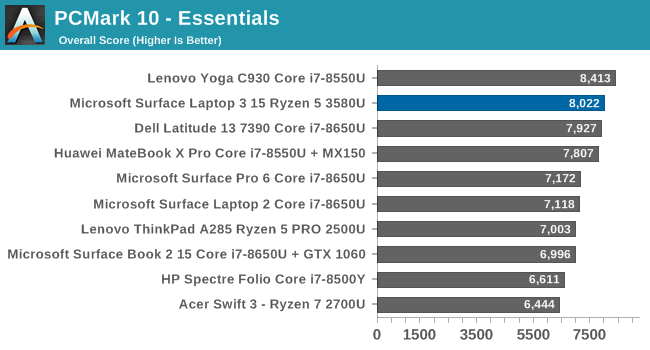
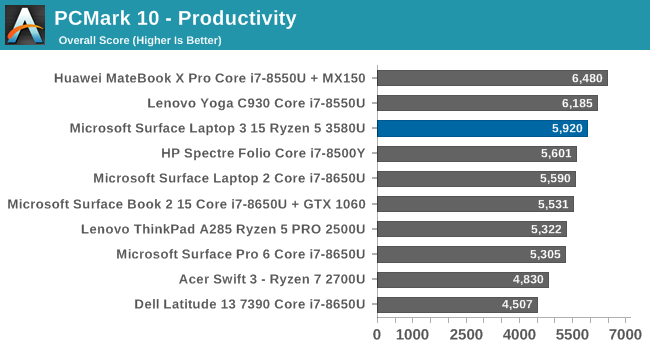
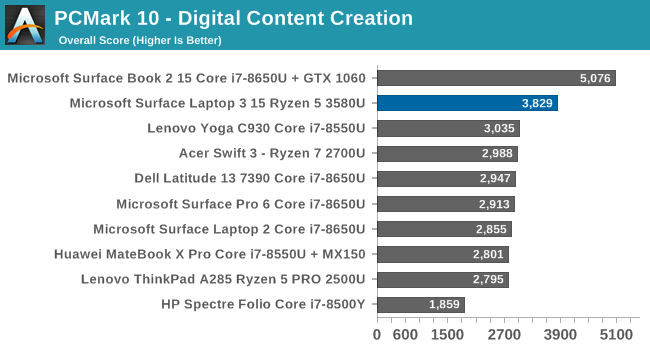

PCMark 10 tests all aspects of a system including the GPU, CPU, and storage, across several sets of subtests. The extra GPU grunt from the Vega 9 really helps in the Digital Content Creation test in particular, but the Zen+ core is competitive with the 8th generation Intel processors in the other tests as well.
Cinebench
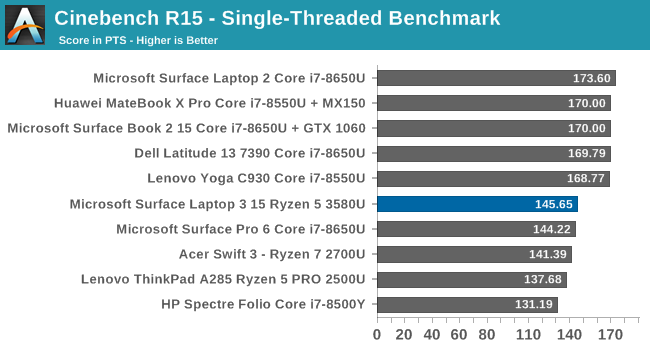
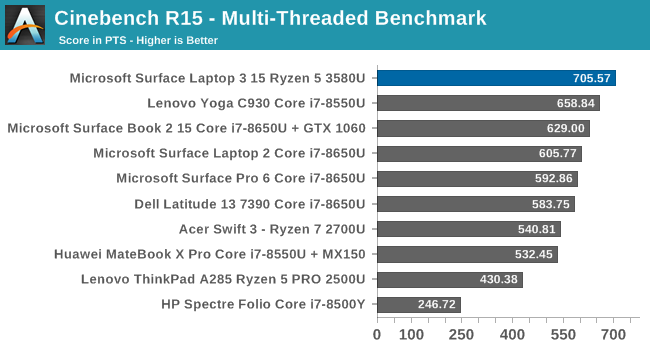
Cinebench offers both single-threaded and multi-threaded variations of its benchmark, and makes it very easy to see that the Zen+ core isn’t quite as quick as the Skylake based processors in the other laptops, but in the multi-threaded variation the Ryzen is able to flex its muscles and climb to the top.
x264
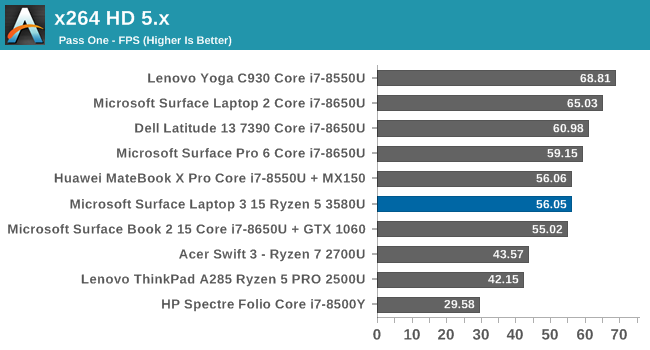

This video conversion test is very CPU intensive and long, meaning devices run into their thermal limits over the duration. The Ryzen 5 3580U once again holds its own here against the last generation Intel products.
Web Results
Browsing the web is easily one of the most popular activities on any PC, but web performance comes down to not only the system, but also the browser. For consistency all of our devices are tested with Microsoft Edge as the browser, which has actually regressed in performance over the last several updates. Microsoft is switching to a Chromium browser, which will become the new platform when it is available, along with some updated scripting tests.
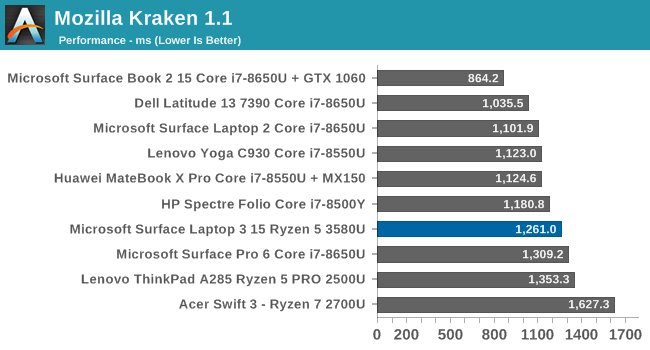
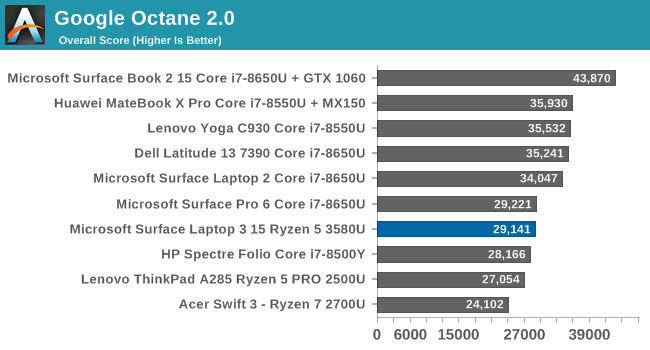
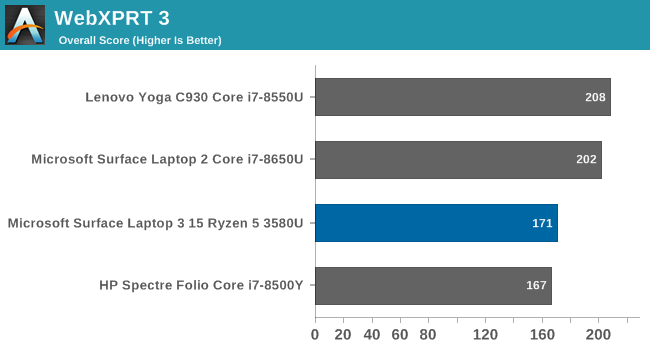
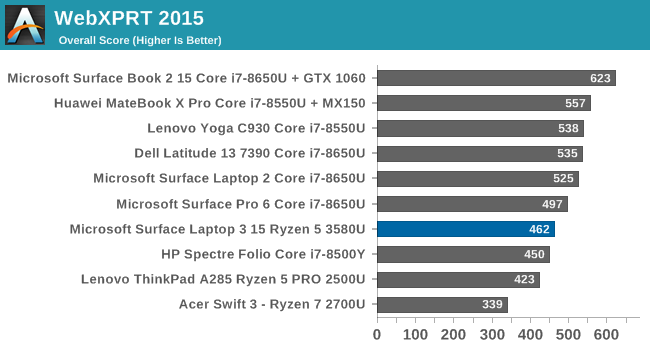
Intel’s Speed Shift technology pays dividends on the web tests, since the workloads quickly ramp up and down, so the AMD Ryzen isn’t quite as competitive in these tests, but the newer Zen+ is still a nice bump in performance over the original 2700U Raven Ridge APU.
Storage Performance
Over the last couple of generations, Microsoft has been utilizing soldered-in BGA SSDs to save space in their designs, but those SSDs were limited to just two PCIe lanes. With the latest round of devices, the SSD is once again removable via an M.2 slot, with Microsoft using a smaller than normal 2230 form factor. Although the SSD isn’t easily replaceable, it is replaceable if necessary, which is a win for consumers on the repair side.
The 2230 drive in our review unit is an SK Hynix model with just 256 GB of space (other models come with a Toshiba BG4) so it doesn’t offer spectacular SSD performance compared to the best 2280 drives on the market. But still gets the job done and does offer the PCIe x4 connectivity the soldered-down models lacked.


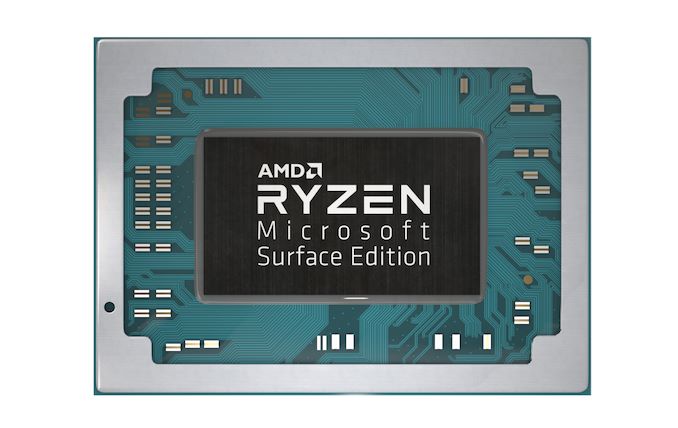
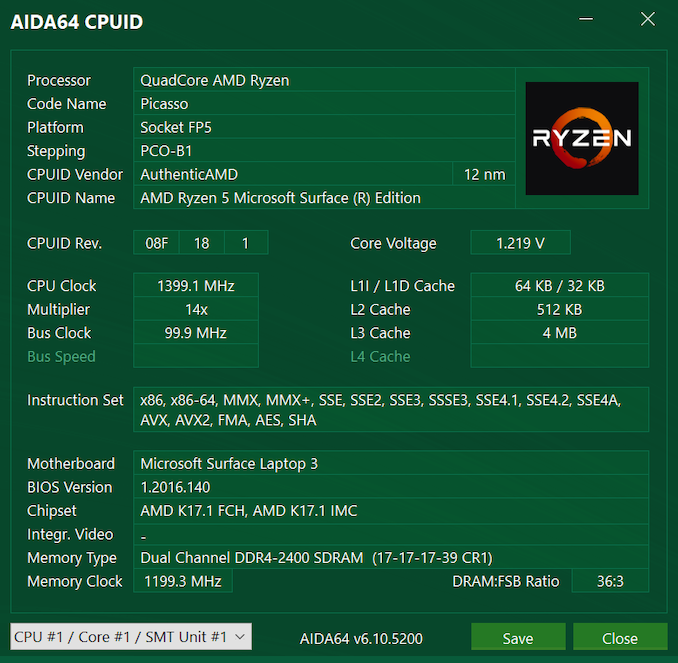
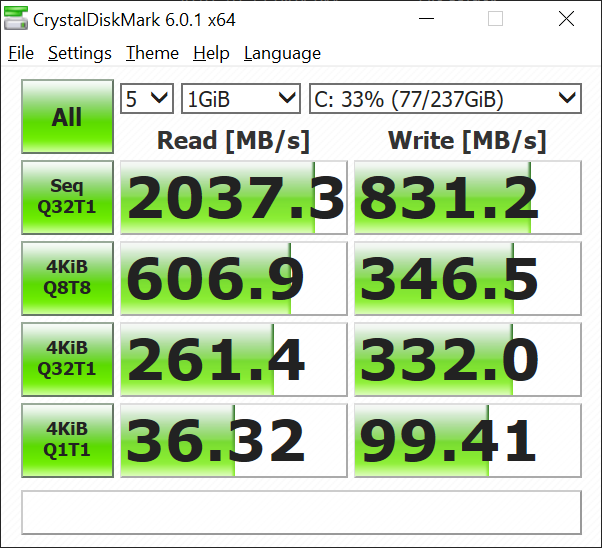








91 Comments
View All Comments
Marlin1975 - Monday, October 21, 2019 - link
For being the base AMD Ryzen model CPU/GPU it performs much better than I though it would. Hopefully you can get a Ryzen 7 version to test soon as well.Rickyxds - Monday, October 21, 2019 - link
The AnandTech is protecting Intel and UHD performance, Why they don't show UHD 630 performance in Rise of the Tomb Raider?they don't show but I will tell you! in the same configuration the UHD 630 offer only 20 fps.
You can search on web the uhd 630 performance on Rise of the Tomb Raider, internet can show!
cyrusfox - Monday, October 21, 2019 - link
UHD 630 is the old Intel GPU(Gen 9.5) found on coffee lake. The new surface has ice lake chips has Gen 11 GPU, Iris plus with 64 EU. Supposedly twice as fast as the prior generation.I am sure we will see cross comparison reviews, especially when someone gets Enterprise 15"(Intel version) to compare straight to consumer 15"(AMD).
justin.anthony.hall - Monday, October 21, 2019 - link
mine is delivered tomorrow, i7 version. I'll let y'all know.mooninite - Monday, October 21, 2019 - link
Early tests of Ice Lake Iris show it is more of the same old junk from Intel. Nothing special. Vega still wins.0ldman79 - Sunday, December 15, 2019 - link
It's just like their previous IGP.Intel brags about "up to 64 EU IGP" then 99% of their SKU have 24 EU or less. One model has 64 EU and that's only their high end i7 K model. Who the hell is going to buy a $600+ CPU and run the IGP? Even if it is Intel's best IGP it's still below a 750 Ti.
Ryan Smith - Monday, October 21, 2019 - link
"Why they don't show UHD 630 performance in Rise of the Tomb Raider?"As you've correctly noted, the short answer is that it's very slow. Too slow to even justify the time benchmarking, unless you like framerates in the teens.
Ultimately the Ryzen APUs are fast enough that we treat them like low-end dGPUs, and that includes running AAA gaming benchmarks on them. The Gen 9.x GT2 GPUs, on the other hand, are decidedly a tier lower for intensive gaming workloads.
Teckk - Monday, October 21, 2019 - link
Good win for AMD not battery life is a bit underwhelming. With the new 1W display for new laptops (based on IceLake?), this needs some serious improvement. AMD needs Ryzen mobile on 7nm soon.A decent laptop but, 128 GB as baseline, really? Good to see they're not offering 4 GB RAM at least. Add another USB port and this is a good enough machine for light home usage.
eastcoast_pete - Monday, October 21, 2019 - link
Thanks for the review! Unfortunately, it confirmed several of my fears - the AMD version of the new Surface is definitely usable, but behind even the previous (Intel) generation of this premium laptop line. The Wifi choices made by MS are indeed questionable at best, while the low battery life points to the basic problem of using a chip not designed for mobile use in an ultraportable. Really wish AMD would roll out a true Zen2+ or better mobile APU with better power management. For now, it continues to play second fiddle to Chipzilla's offerings.GreenReaper - Monday, October 21, 2019 - link
Microsoft is likely to be one of their first customers for this, too... in their consoles. Realistically we'll only start seeing new PCs with equivalent APUs around that time - most likely with 802.11ax Wi-Fi as well in the case of the inevitable Surface Laptop 4.